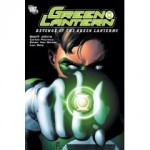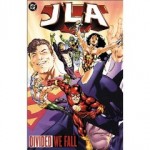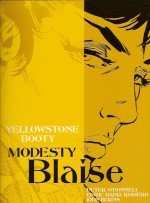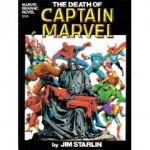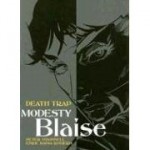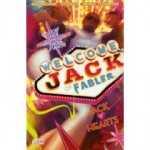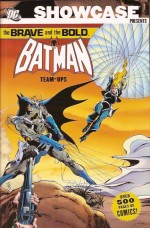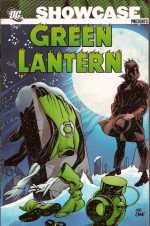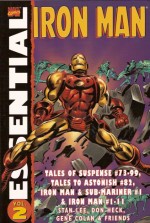
By Stan Lee, Roy Thomas, Archie Goodwin, Gene Colan, George Tuska, Johnny Craig, & various (Marvel)
ISBN: 978-1-90415-975-9
Marvel’s rise to dominance of the American comicbook industry really took hold in 1968 when most of their characters finally got their own titles. Prior to that and due to a highly restrictive distribution deal the company was tied to a limit of 16 publications per month. To circumvent this drawback, Marvel developed “split-books†with two features per publication, such as Tales of Suspense where Iron Man was joined by Captain America with #59 (cover-dated November 1964). When the division came the armoured Avenger started afresh with a “Collectors Item First Issue†– after a shared one-shot with the Sub-Mariner that squared divergent schedules – and Cap retained the numbering of the original title; thus premiering in number #100.
This second sterling black and white chronological compendium covers that transitional period, reprinting Tales of Suspense #73-99, Iron Man and the Sub-Mariner #1 and Iron Man #1-11, and also includes the Subby portion of Tales to Astonish #82, which held a key portion of an early comics crossover.
Tony Stark is the acceptable face of 1960s Capitalism; a glamorous millionaire industrialist and inventor – and a benevolent all-conquering hero when clad in the super-scientific armour of his alter-ego, Iron Man. Created in the aftermath of the Cuban Missile Crisis and at a time when “Red-baiting†and “Commie-bashing†were American national obsessions, the emergence of a brilliant new Thomas Edison, using Yankee ingenuity and invention to safeguard and better the World seemed inevitable. Combine the then-sacrosanct belief that technology and business could solve any problem with the universal imagery of noble knights battling evil and the concept behind the Golden Avenger seems an infallibly successful proposition. Of course it helps that all that money and gadgetry is great fun and very, very cool…
This volume begins with Tales of Suspense #73 (cover-dated January 1966) and picks up, soap opera fashion, on Iron Man, rushing to the bedside of his best friend Happy Hogan, gravely wounded in an earlier battle, and now missing from his hospital bed. ‘My Life for Yours!’ by a veritable phalanx of creators including Stan Lee, Roy Thomas, Gene Colan & Jack Abel (in their Marvel modes of Adam Austin and Gary Michaels), Sol Brodsky, Flo Steinberg and Marie Severin, pitted the Avenger in final combat against the Black Knight to rescue Happy but after this the creative stabilised at Lee, Colan and Abel, for ‘If this Guilt be Mine..!’ wherein Tony Stark’s inventive intervention saved his friend’s life but transformed the patient into a terrifying monster.
Whilst in pitched battle against ‘The Fury of… the Freak!’ (who scared the stuffings out of me as an comic-crazed seven-year-old!), Iron Man was helpless when the Mandarin attacked in #76’s ‘Here Lies Hidden…the Unspeakable Ultimo!’ The saga continued in ‘Ultimo Lives!’ and closed as the gigantic android went berserk in ‘Crescendo!’ dooming itself and allowing our ferrous hero to escape home, only to face a Congressional Inquiry and a battle crazed Sub-Mariner in ‘Disaster!’ The Prince of Atlantis had been hunting his enemy Warlord Krang in his own series, and the path led straight to Stark’s factory, so when confronted with another old foe the amphibian over-reacted in his usual manner.
‘When Fall the Mighty!’ in Tales of Suspense #80, was one colossal punch-up, which carried over into Tales to Astonish #82, where Thomas and Colan began the conclusion before the penciller contracted flu after delivering only two pages. Jack Kirby, inked by Dick Ayers, stepped in to produce some of the finest action-art of his entire Marvel career, fully displaying ‘The Power of Iron Man!’
TOS #81 featured ‘The Return of the Titanium Man!’ – and Gene Colan – as the Communist Colossus attacked the Golden Avenger on his way to Congress, and threatened all of Washington DC in the Frank Giacoia inked ‘By Force of Arms!’ before succumbing to superior fire power in ‘Victory!’ Stark’s controversial reputation was finally restored as the public finally discovered that his life was only preserved by a metallic chest-plate to kept his heart beating in ‘The Other Iron Man!’ – but nobody connected that hunk of steel to the identical one his Avenging “bodyguard†wore…
The Mandarin kidnapped the inventor’s recovering pal – temporarily wearing the super-suit – in another extended assault that began with ‘Into the Jaws of Death’ which compelled the ailing Stark to fly to his rescue in ‘Death Duel for the Life of Happy Hogan!’, in #87-88 the Mole Man attacked in ‘Crisis… at the Earth’s Core!’ and ‘Beyond all Rescue!’ and it was the turn of another old B-List bad-guy in ‘The Monstrous Menace of the Mysterious Melter!’ and its sequel ‘The Golden Ghost!’
‘The Uncanny Challenge of the Crusher!’ is an okay battle tale somewhat marred for modern audiences by a painful Commie-Bustin’ sub-plot featuring a thinly disguised Fidel Castro, and the impressions of the on-going “Police Action†in Indo-China are also a little gung-ho (if completely understandable) when Iron Man went hunting for a Red Menace called Half-Face ‘Within the Vastness of Viet Nam!’ and met an incorrigible old foe in ‘The Golden Gladiator and… the Giant!’ before snatching victory from Titanium jaws of defeat in ‘The Tragedy and the Triumph!’ (this last inked by Dan Adkins).
A new cast member was introduced in #95 as preppie S.H.I.E.L.D. agent Jasper Sitwell was assigned as security advisor to America’s most prominent weapons maker, just as the old Thor villain Grey Gargoyle attacked in ‘If a Man be Stone!’ and ‘The Deadly Victory!’
Tales of Suspense #97 began an extended story-arc that would carry the series to the start of the solo-book and beyond. Criminal cartel the Maggia had a scheme to move in on Stark’s company which opened with ‘The Coming of… Whiplash!’ proceeded to ‘The Warrior and the Whip!’ and as the brilliant Archie Goodwin assumed the scripting reins and EC legend Johnny Craig came aboard as inker Iron Man found himself trapped on a sinking submarine ‘At the Mercy of the Maggia’, just as Tales of Suspense ended at #99…
Of course it was just changing its name to Captain America, as Tales to Astonish seamlessly transformed into the Incredible Hulk, but due to a scheduling snafu neither of those split-book co-stars had a home that month (April 1968) which led to the one-and-only Iron Man and the Sub-Mariner #1, and the concluding episode ‘The Torrent Without… The Tumult Within!’ wherein the sinister super-scientists of A.I.M. (Advanced Idea Mechanics, acronym-fans) snatch the Armoured Avenger from the Maggia sub intent on stealing the hero’s technical secrets.
Invincible Iron Man #1 finally appeared with a May 1968 cover-date, and triumphantly ended the extended sea-saga as our hero stood ‘Alone against A.I.M.!’, a thrilling roller-coaster ride that was supplemented by ‘The Origin of Iron Man’ a revitalised re-telling that ended Colan’s long and impressive tenure on the character. With #2, ‘The Day of the Demolisher!’, Craig took over the art, and his first job is a cracker, as Goodwin introduced Janice Cord a new romantic interest for the playboy, the killer robot built by her deranged father and a running plot-thread that examined the effects of the munitions business and the kind of inventors who work for it…
Following swiftly on Goodwin and Craig brought back Happy Hogan’s other self in ‘My Friend, My Foe… the Freak!’ in #3 and retooled a long-forgotten Soviet villain into a major threat in ‘Unconquered is the Unicorn!’ before George Tuska, another Golden Age veteran who would illustrate the majority of the Iron Man’s adventures over the next decade. Inked by Craig, ‘Frenzy in a Far-Flung Future!’ is a solid time-paradox tale wherein Stark is kidnapped by the last survivors of humanity, determined to kill him before he can build the super-computer that eradicated mankind. Did somebody say “Terminatorâ€â€¦
The super-dense (by which I mean strong and heavy) Commie threat returned – but not for long – in ‘Vengeance… Cries the Crusher!’ and the scheme begun in TOS #97 finally bore painful fruit in the two-part thriller ‘The Maggia Strikes!’ and ‘A Duel Must End!’ as the old Daredevil foe the Gladiator led a savage attack on Stark’s factory, friends and would-be new love…
This volume ends with a bold three-part saga as the ultimate oriental arch-fiend returned with a cunning plan and the conviction that Stark and Iron Man were the same person. Beginning in a “kind-of†Hulk guest-shot with #9’s ‘…There Lives a Green Goliath!’ proceeding through the revelatory ‘Once More… The Mandarin!’ and climaxing in spectacular “saves-the-day†fashion as our hero is ‘Unmasked!’, this epic from Goodwin, Tuska and Craig ends the book on a brilliant high note, just as the first inklings of the social upheaval America was experiencing began to seep into Marvel’s publications and their core audience started to grow into the Flower Power generation. Future tales would take the arch capitalist Stark in many unexpected and often peculiar directions…
But that’s a tale for another review, as this sparkling graphic novel is done. Despite some rough patches this is a fantastic period in the Golden Gladiator’s career and one perfectly encapsulates the changes Marvel and America went through: seen through some of the best and most memorable efforts of a simply stellar band of creators.
© 1966, 1967, 1968, 1969, 2004 Marvel Characters, Inc. All Rights Reserved.
